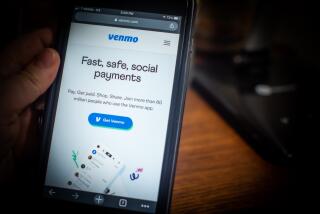New Web Site a Money Exchange for Users
- Share via
You’ve got money!
One of the nation’s largest banks has launched a Web site that will allow Grandma to send $50 birthday checks via e-mail and parents to electronically zap emergency loans from their credit cards to a college student’s bank account.
EMoneyMail, a unit of Bank One Corp. in Chicago, is offering the new service to anyone seeking to transfer up to $500, as long as both individuals have e-mail addresses.
It marks the boldest move yet by a major bank into the rapidly emerging business of consumer-to-consumer electronic payments and opens a new front in the war over bank customers.
Analysts predict that the new service will increase consumer acceptance and awareness of emerging technologies for electronic payments by providing a simple, fast and low-cost way to transfer money online.
“We are seeing the beginning of a new, credible form of digital cash transfer,” said Robert Sterling, analyst at Jupiter Communications, a research firm. “This could change the way people interact with their banks and how they use their credit cards.”
Under the new service, consumers can transfer money from their credit card, debit card or checking account and send it to someone else via e-mail. Users do not have to be Bank One customers, but senders must pay a $1 fee.
After opening the e-mail notice, recipients link to the EMoneyMail.com Web site, where they can direct the money to their own credit card, debit card or checking account. There is no fee to recipients unless they request a printed check, which costs $1.
Bank One officials predict that one in five U.S. households may eventually use e-mail-based payments, replacing many of the smaller transactions that are now conducted with cash or checks. The bank also anticipates the service will compete with money-transfer companies, such as Western Union, and will be used for electronic bill-paying, particularly with small businesses.
Some analysts questioned whether e-mail payments will catch on with consumers once the novelty wears off.
“It’s a great marketing tool to get customers,” said Jim Bruene, editor of Online Banking Report in Seattle. “I just don’t know how broad the appeal will be.”
Nevertheless, analysts expect that other banks will follow Bank One into the e-mail payment business as a way to attract online customers and increase traffic at their Web sites. Recent experience also has shown that online bank customers are more profitable and loyal than other bank customers.
“They are the cream of the customer base,” Sterling said.
Earlier this month, Wells Fargo Bank launched a joint venture with EBay Inc. for a similar person-to-person payment service, but it is limited to the online auction company’s shoppers. A Wells Fargo spokeswoman said Wednesday that the San Francisco bank is hoping to expand the service.
Some other banks, like Bank of America, offer consumer-to-consumer electronic payment through their online banking systems but only for their own customers.
Banks feel the need to push into these new online financial services amid a growing threat from nonbank Internet leaders--from Microsoft Corp. to CheckFree Holdings--that have been stealing customers by offering such products as online bill-paying and bill-delivery.
“We are targeting the bank customer,” said Peter Thiel, president of PayPal.com, an Internet start-up that began offering its own e-mail payment service last fall. “Eventually we envision rolling into a full financial services company, offering checking accounts and savings accounts.”
Last week, PayPal.com said it would merge with rival X.com Corp. to create a company with 700,000 users. Like many Internet firms, the companies have been sacrificing profits to build market share quickly, offering its service at no charge and giving away $10 bonuses to first-time users.
But Bank One officials say their size and experience in handling money will give them an advantage, particularly as consumers become more concerned about the security and privacy of online transactions.
“Knowing that a large bank is involved instantly gives the service a level of credibility that a normal Web site wouldn’t have,” said Dean Lehman, senior vice president at Bank One.
But PayPal’s Thiel said banks lack the skills and creativity to excel online. “Banks have failed abysmally in most of their attempts to enter the Internet space,” he said.
(BEGIN TEXT OF INFOBOX / INFOGRAPHIC)
The Check’s In The E-Mail
Bank One launched a new Internet service Wednesday that allows consumers to pay one another online. Here’s how it works:
*
Sender
1. Registers at eMoneyMail Web site by providing name and e-mail address.
2. Provides credit card, debit card or checking account number and enters amount to be paid. (Credit and debit card transactions occur immediately; checking account withdrawals take up to four business days.)
3. Enters e-mail address of recipient; agrees to $1 fee.
4. Clicks send.
*
Recipient
1. Opens e-mail and links to eMoneyMail Web site.
2. Directs money to credit card, debit card or checking account; money is transferred at no charge.
3. To receive a printed check in mail, recipients must pay $1.
*
MORE TECHNOLOGY NEWS: C6-7
More to Read
Inside the business of entertainment
The Wide Shot brings you news, analysis and insights on everything from streaming wars to production — and what it all means for the future.
You may occasionally receive promotional content from the Los Angeles Times.










